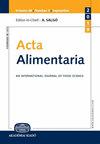用新鲜酸枣发酵提高枣酒的香气和感官特征。木藻处于白熟期
IF 1
4区 农林科学
Q4 FOOD SCIENCE & TECHNOLOGY
引用次数: 0
摘要
本文以鲜木枣(Zizyphus jujuba cv.Muzao)为原料,在不经蒸煮和提取的条件下,直接酿造低度枣酒。结果表明,在相同的枣果水配比下,白熟枣酒(WRJW)的总酸、总酚和总单宁含量均显著高于全红枣酒(FRJW)(P<0.05),当枣果水比从1:1增加到1:5时,WRJW的总酯含量从2261.56增加 μg L−1至3671.51 μg L−1,但FRJW降低。其中,WRJW(1∶5)中辛酸乙酯、癸酸乙酯和辛酸异戊酯的含量明显高于其他葡萄酒样品(P<0.05),这三种酯具有多种香气描述特征,可使枣酒风味更加复杂。感官评估也显示WRJW(1:5)得分最高。该酒具有以下特点:清澈透明,淡黄色,果香清雅,酒香怡人,酒体和谐,口感清新,酸甜可口,具有典型的枣酒特点。研究结果可为红枣酒的工业化生产提供理论依据和技术参考。本文章由计算机程序翻译,如有差异,请以英文原文为准。
Enhancement of aromatic and sensory profile of jujube wines fermented with fresh Zizyphus jujuba cv. Muzao at the white-ripe period
In this paper, fresh Muzao (Zizyphus jujuba cv. Muzao) at full-red and white-ripe periods were used as raw materials to brew low-alcohol jujube wines directly without cooking or extraction. The results showed that the contents of total acid, total phenolics, and total tannin of white-ripe jujube wines (WRJW) were significantly higher than that of full-red jujube wines (FRJW) under the same ratio of jujube fruit/water (P < 0.05). When the ratio of jujube fruit to water increased from 1:1 to 1:5, the total esters contents of WRJW increased from 2261.56 μg L−1 to 3671.51 μg L−1, but decreased in FRJW. Especially, the contents of ethyl octanoate, ethyl decanoate, and isoamyl caprylate in WRJW (1:5) were significantly higher than in other wine samples (P < 0.05). These three esters with a variety of aroma description characteristics can give jujube wine a more complex flavour. The sensory evaluation also showed that the WRJW (1:5) had the highest score. This wine had the following characteristics: clear and transparent, light yellow, pure elegant fruit and wine aroma, pleasant fragrance, harmonious wine body, fresh taste, sweet and sour, with typical characteristics of jujube wine. The research results can provide a theoretical basis and technical reference for the industrial production of high-quality jujube wine.
求助全文
通过发布文献求助,成功后即可免费获取论文全文。
去求助
来源期刊

Acta Alimentaria
农林科学-食品科技
CiteScore
1.80
自引率
0.00%
发文量
47
审稿时长
18-36 weeks
期刊介绍:
Acta Alimentaria publishes original papers and reviews on food science (physics, physical chemistry, chemistry, analysis, biology, microbiology, enzymology, engineering, instrumentation, automation and economics of foods, food production and food technology, food quality, post-harvest treatments, food safety and nutrition).
 求助内容:
求助内容: 应助结果提醒方式:
应助结果提醒方式:


